Low-disturbance toolbar expands tillage options
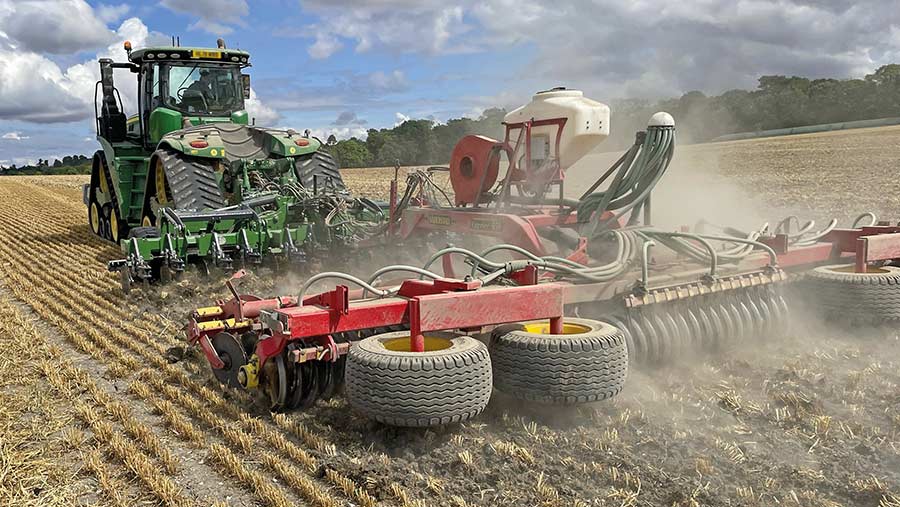 © Joe White
© Joe White Managing a 1,600ha mainly arable operation with variable soil types and a significant blackgrass burden requires a flexible approach to crop establishment.
That’s why Joe White, farm manager at Cannon Heath Farm, Kingsclere, Hampshire, likes to keep a range of cultivation and drilling kit at his disposal.
No-till drills have been used on the farm for the past 15 years, but throughout that period they’ve been accompanied by a ruck of other ground-engaging machinery and a trusty Vaderstad Rapid min-till drill.
See also: Bespoke liquid fert kits improve no-till drilled crop performance
“I’m conscious that we’ve got too much kit, but all of it plays a part and I don’t believe we can do a good job putting our faith in just one system,” says Mr White.
“Sometimes soil conditions in parts of the farm just aren’t suitable for no-till drilling, so we need to cultivate or lift the ground to achieve good crop establishment.
“However, all workings on the farm are minimum tillage and most of the land hasn’t seen a plough for 30 years.”
Agriweld Assist low-disturbance toolbar
A key part of the farm’s system is a 6m Agriweld Assist low-disturbance toolbar, which can be used as a standalone implement for lifting ground or teamed with other pieces of equipment.
It mounts to the tractor’s rear linkage and has a series of lifting legs, each with a leading disc that cuts the ground to reduce soil movement and prevent trash collecting.
Cannon Heath Farm’s Agriweld Assist
- Width 6m
- Number of legs Eight or 12
- Point width 75mm
- Disc diameter 460mm
- Maximum working depth 300mm
- Leg protection Shear tabs
- Price paid £26,000
At the rear, it has the option of a three-point linkage for carrying mounted implements, or a drawbar for pulling trailed machines.
In this latter configuration, it has a neat half-fold function that lifts the wings so that they don’t hit the implement when turning on the headland.
Thanks to adjustable spacing, the Assist toolbar can be used with 12 legs at 500mm for preparing cereal ground, or eight legs set at 750mm for working fields destined for maize.
This ability was a big factor in Mr White choosing the Agriweld toolbar over other makes.
He was particularly impressed with the system for moving the position of the legs, as they simply hook off one set of brackets and can be moved onto the next.
“It’s a very neat design and it takes us no time to switch them around.”
The aim of the toolbar is to lift the ground at reasonable speeds without causing soil to boil up around the leg.
Wing size plays a big part in this and, after testing different sizes, Mr White and his team settled on a Sumo point with 75mm wings.
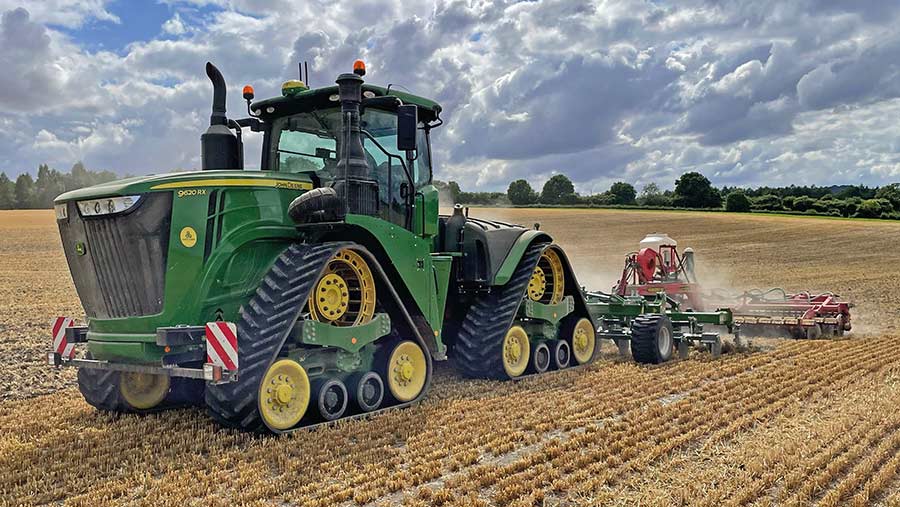
© Joe White
Cereal establishment
The farm uses the Assist toolbar in several different ways when preparing ground for cereal crops.
For post-harvest stubble cultivation, it’s often coupled to a Vaderstad Carrier, with the toolbar lifting the ground to a depth of about 150mm and the Carrier working up some tilth to encourage weed seeds to germinate.
Cover crops are also established using this combination, with the addition of a seeder unit and a series of spreader plates on the cultivator.
Often, the farm’s 6m John Deere 750A no-till disc drill will sow spring crops directly into this cover following desiccation, meaning no further cultivation is required.
Another common use for the Assist is autumn seed-bed preparation, where it is partnered with a heavy Michael Moore press that had been languishing on the farm for years.
This helps push down the small ridge of soil created by the leg, giving a level surface for the 750A or Vaderstad Rapid to work on.
Previously, this task was put in the hands of a set of 6m Cambridge rolls, but these weren’t heavy enough to seal moisture in the top 50mm effectively.
Occasionally, the toolbar is used with the Vaderstad drill hooked directly on the rear, making a true single-pass operation. In this situation, a straw rake may be used to create a chit beforehand.
However, it’s more common for them to do the cultivation work first, not use the rake, and drill later at a 30deg angle.
The John Deere 750A is not used directly on the toolbar as some of the discs follow directly behind a leg and give uneven drilling depth.
It is possible to adjust individual coulter pressure to help counteract this, but Mr White and his team found it difficult to get this right with such variable conditions across the width of the drill.
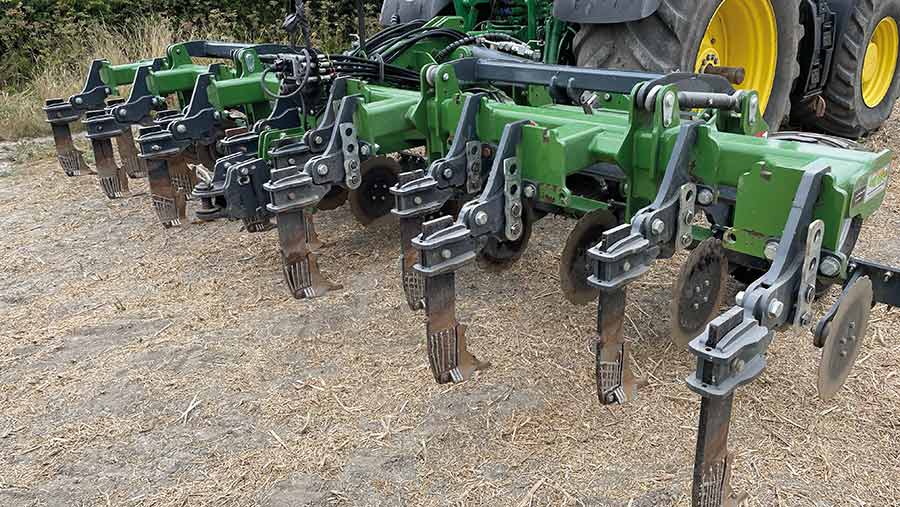
© Joe White
Maize establishment
The farm uses the Assist toolbar in several different ways when preparing ground for cereal crops.
For post-harvest stubble cultivation, it’s often coupled to a Vaderstad Carrier, with the toolbar lifting the ground to a depth of about 150mm and the Carrier working up some tilth to encourage weed seeds to germinate.
Cover crops are also established using this combination, with the addition of a seeder unit and a series of spreader plates on the cultivator.
Often, the farm’s 6m John Deere 750A no-till disc drill will sow spring crops directly into this cover following desiccation, meaning no further cultivation is required.
Another common use for the Assist is autumn seed-bed preparation, where it is partnered with a heavy Michael Moore press that had been languishing on the farm for years.
This helps push down the small ridge of soil created by the leg, giving a level surface for the 750A or Vaderstad Rapid to work on.
Previously, this task was put in the hands of a set of 6m Cambridge rolls, but these weren’t heavy enough to seal moisture in the top 50mm effectively.
Occasionally, the toolbar is used with the Vaderstad drill hooked directly on the rear, making a true single-pass operation.
In this situation, a straw rake may be used to create a chit beforehand. However, it’s more common for them to do the cultivation work first, not use the rake, and drill later at a 30deg angle.
The John Deere 750A is not used directly on the toolbar as some of the discs follow directly behind a leg and give uneven drilling depth.
It is possible to adjust individual coulter pressure to help counteract this, but Mr White and his team found it difficult to get this right with such variable conditions across the width of the drill.
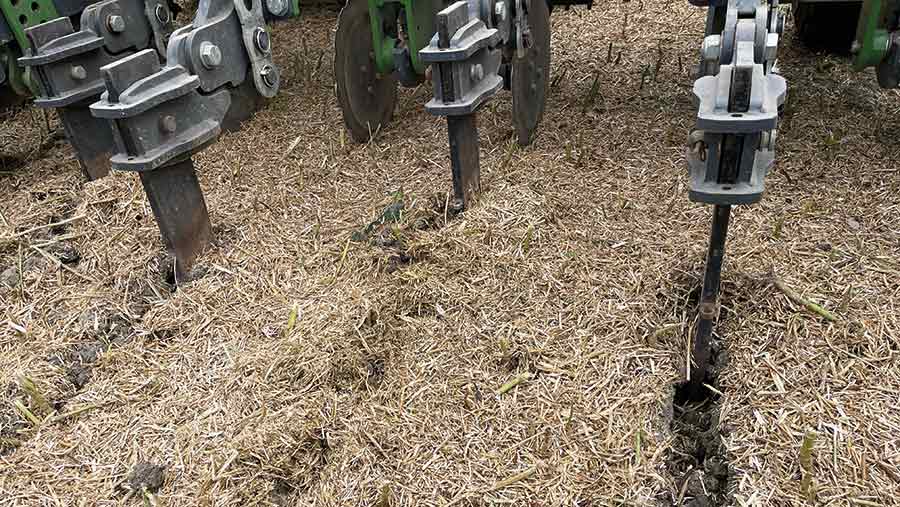
© Joe White
Tractor power
Due to the toolbar’s low-disturbance legs, and the fact it doesn’t get worked deeper than 200mm, it can be pulled by the farm’s 215hp John Deere 6215R.
Coupling it to a press or drill usually requires some additional firepower, so duties are handed to a 290hp 7290R.
This has plenty of grunt for most situations, but working speed is generally limited to less than 10kph to avoid moving too much soil.
Occasionally, the farm’s 9RX is also pressed into service, usually on the steeper ground and when soils are baked particularly hard.
However, this tractor’s primary role is pulling a 6.7m Gregoire Besson Discordon, which is deployed only when the soil has gone tight and needs a bit more disturbance than the Assist can offer.
“I don’t like using the Discordon as we burn so much fuel pulling it, but sometimes it’s just what the soil needs and we’d miss it if we sold it,” says Mr White.
Modifications
The Assist toolbar worked well from the off, but some alterations have been made, and others are in the pipeline.
Firstly, the farm’s combination of flint and greensand soils is particularly hard on wearing metal and a set of toolbar points can be ready for the scrap bin after 40-70ha, depending on the work.
For this reason, hard-facing weld has been applied to the sides of the legs and tops of the wings to eke some extra life out of them.
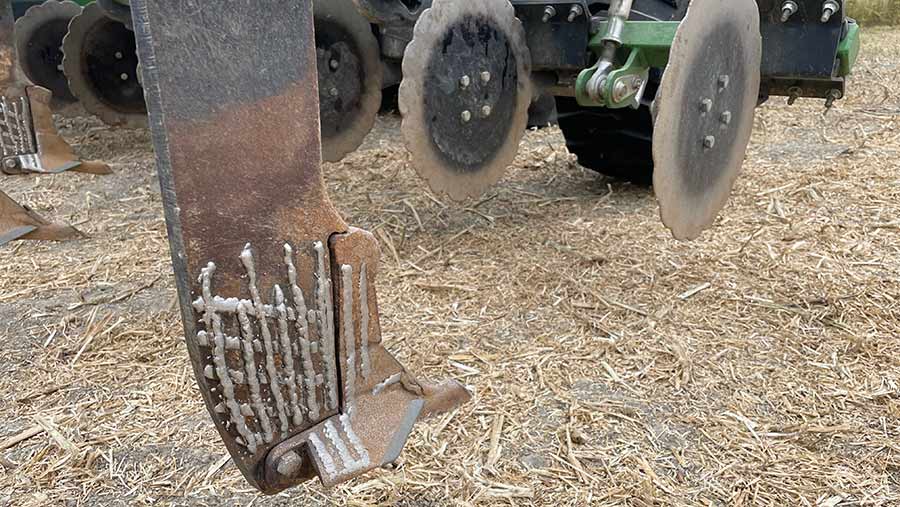
© Joe White
Also, when the toolbar is being used as a strip-till cultivator for preparing maize ground, it can throw soil too far from the leg, even at slower speeds.
To counteract this, Agriweld is working on a pair of detachable floating discs that can be bolted either side of the leg to keep the soil in a tight band.
“Ideally, I’d have a dedicated strip till machine, but I wanted row-width flexibility and I think we can achieve the right results by modifying what we’ve already got,” says Mr White.
Other possible modifications are the addition of a seeder unit for establishing companion crops in the inter-row and the ability to fit nozzles between the legs to create a band sprayer

